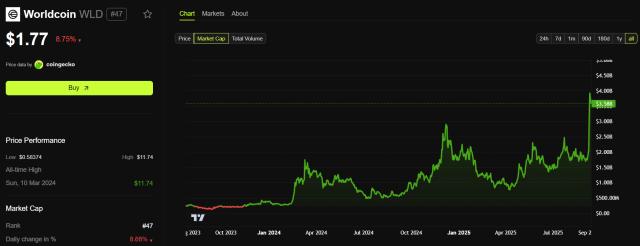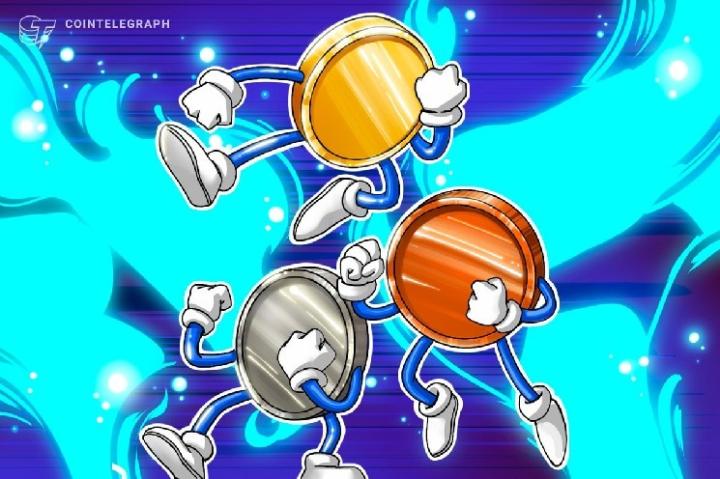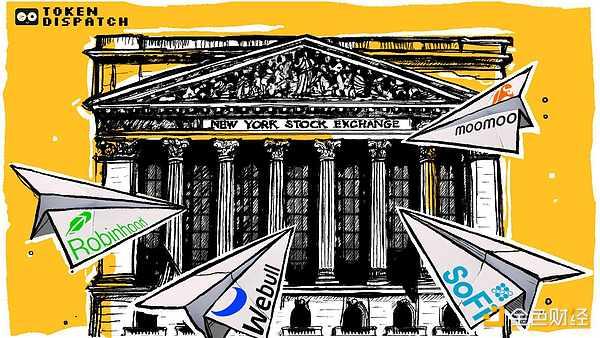As the world's largest stablecoin network, TRON handles approximately 60% of stablecoin transaction traffic. According to an August CoinDesk research report, 35 of the 50 countries surveyed directly listed TRON as the preferred blockchain for stablecoin payments. This global popularity means that every change in its on-chain gas fees captures the attention of users worldwide.
At the end of August, TRON launched its largest-ever fee optimization since its mainnet launch: the price of Energy, a core component of gas on the TRON network, dropped from 0.00021 TRX to 0.0001 TRX, a nearly 60% decrease. This was accompanied by the implementation of a quarterly dynamic adjustment mechanism to ensure that fees can flexibly adapt to ecosystem needs. This significant adjustment quickly ignited the crypto community, sparking debate over how to achieve optimal gas fees on TRON.
As the official lending platform of the TRON ecosystem, JustLend DAO is committed to reducing user on-chain costs and has launched two key cost-reduction solutions: Energy Rental, which allows users to rent energy on-demand, per-transaction, without the need for long-term TRX staking, thereby directly reducing gas costs per transaction; and GasFree, a smart wallet feature that completely breaks the traditional restriction of "paying gas fees with native assets" by allowing users to directly deduct transaction fees using transfer tokens (such as USDT), significantly simplifying the on-chain transfer process.
Today, on the TRON network, users can easily achieve the optimal gas fee experience by leveraging JustLend DAO's two major functions: "Energy Leasing + GasFree." Users no longer need to worry about the reserves of native tokens or bear high transaction fees, and can truly enjoy the convenience and affordability of on-chain interactions.
TRON Energy Mechanism and the "Energy Leasing Business": The Resource Allocation Logic Behind Low-Cost Interaction
In terms of gas fee management, the TRON network adopts a unique dual-resource model of " Bandwidth + Energy." This differentiates resource allocation for different on-chain operations, allowing developers to precisely control costs while also providing a core advantage that sets it apart from other public chains. It is particularly well-suited for high-frequency, small-value, and complex on-chain interactions, such as DeFi and GameFi.
The two correspond to the resource requirements of different on-chain operations: Bandwidth can be regarded as the basic resource of the TRON network, mainly used to measure the storage and network resource usage of transactions. All on-chain operations consume bandwidth and can be completed with bandwidth alone; energy is more like a high-level resource, specifically supporting smart contract-related operations, such as DeFi calculations, NFT minting, TRC20 token creation, Meme token transfers and other complex DApp interactions, all of which require energy.
Simply put, basic on-chain operations such as TRX transfers, voting, and staking do not require the use of smart contracts and can be completed by consuming only bandwidth. However, if DApps are used (such as depositing and borrowing TRX in JustLend DAO), contracts are touched and a combination of "bandwidth + energy" must be paid.

[Staking TRX only consumes bandwidth]
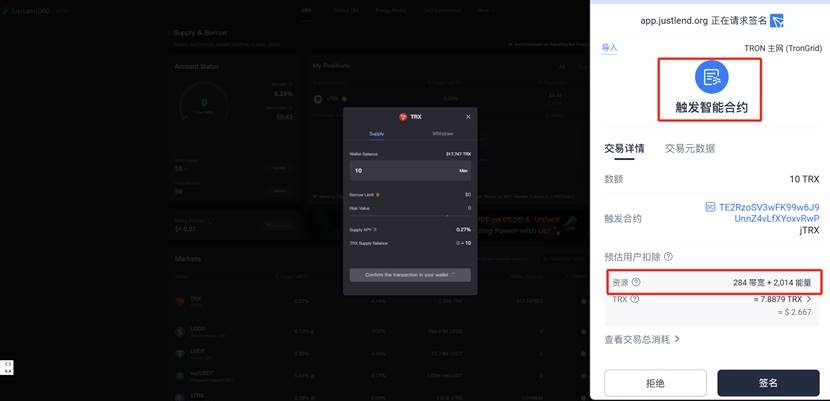
[Using JustLendDAO to store TRX triggers the smart contract, which consumes energy and bandwidth.]
This dual resource model of "bandwidth + energy" is the key difference between TRON and EVM networks like Ethereum, BNB Chain, and Base. In EVM networks, all operations are uniformly priced based on gas fees, from simple transfers and storage to complex smart contract invocations. Miners prioritize transactions with high gas fees, causing costs to skyrocket even for small transfers during peak network times, with fee fluctuations far exceeding expectations. TRON's decoupled bandwidth and energy design cleverly circumvents this issue: simple transactions are supported by bandwidth, while complex contract operations are charged based on energy. This not only ensures fair contract execution but also makes costs more transparent and predictable, preventing ordinary users from being deterred by high costs and avoiding unnecessary resource waste during complex operations.
In terms of acquisition methods, bandwidth and energy are both related and distinct: both can be obtained by staking TRX, but bandwidth is provided with a free quota of 600 units per day, sufficient to cover daily transfer needs . If the free quota is exhausted, users can either stake TRX to obtain bandwidth or directly burn TRX to purchase it. The price per unit of bandwidth is always fixed at 0.001 TRX. Energy, on the other hand, has no free quota. Every contract-related interaction consumes energy , and the amount consumed is positively correlated with the complexity of the contract. Therefore, the unit price of energy directly determines the cost of using DApps. Each transaction will prioritize using the energy already in the wallet address to offset it. If the amount is insufficient, TRX must be burned in exchange for energy.
As the TRON ecosystem prospers (e.g., increased USDT circulation and increased DApp interactions), energy consumption has increased year by year, and the rising TRX price has also driven up energy costs. To reduce network gas fees, TRON has implemented two major price reductions since September of last year, each exceeding 50%: first, from 0.00042 TRX to 0.00021 TRX in September of last year, and most recently, from 0.00021 TRX to 0.0001 TRX on August 29th of this year. This directly reduced the energy cost of smart contract operations by 60%. At the same time, a quarterly dynamic adjustment mechanism has been introduced, whereby Super Representatives will optimize the unit price based on TRX prices and network activity indicators to ensure that costs are aligned with ecosystem needs.
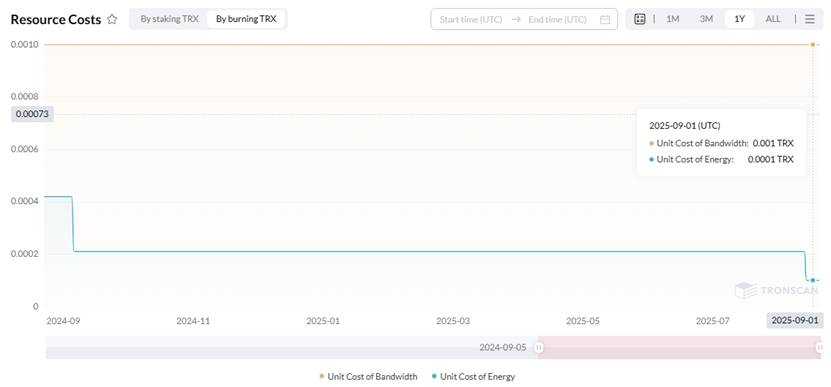
Currently, there are three main ways for users to obtain energy:
The first is to obtain it by staking TRX. Daily Energy is allocated according to the proportion of the staked TRX to the total staked amount of the entire network. For example, on September 5th, 10 units of Energy will be obtained for every 1 TRX staked.
The second is to burn TRX to purchase. The current unit price of energy is 0.0001TRX;
The third is leasing, which is the temporary use of idle energy pledged by others. For example, in JustLend DAO, 2.6 TRX can be used to rent 100,000 energy, which can meet the needs of two transactions.
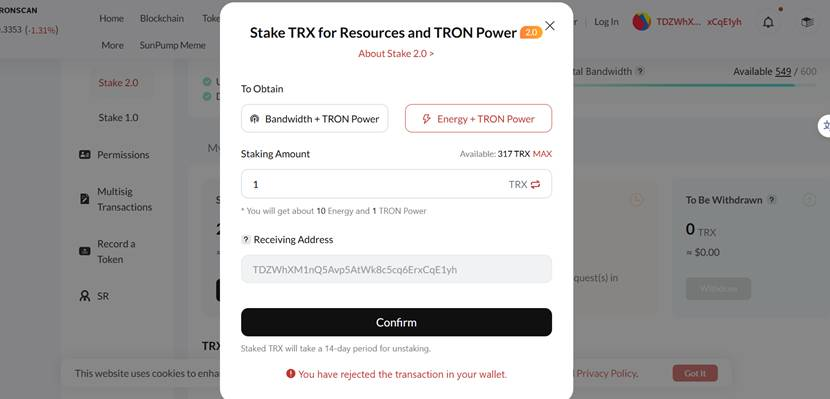
[Method 1: Stake TRX to obtain Energy]
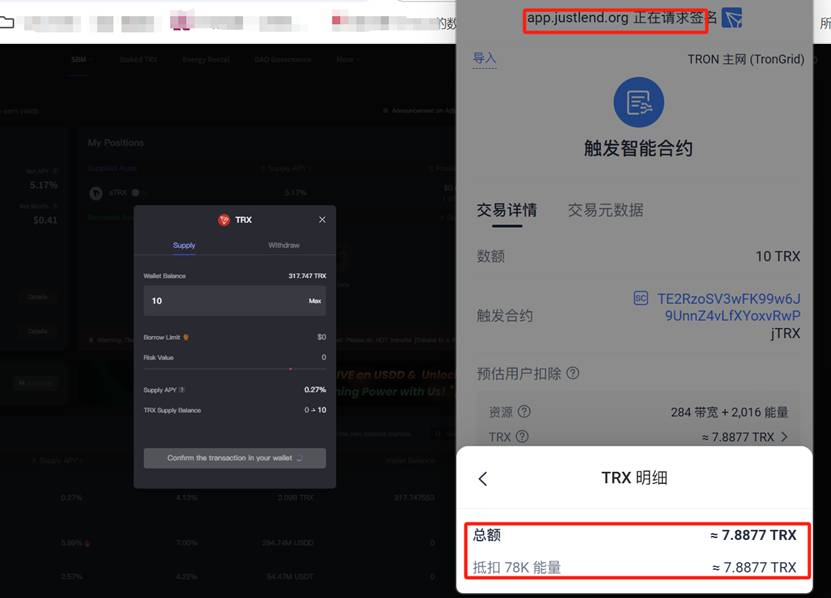
[Method 2: Directly burn TRX to obtain energy]
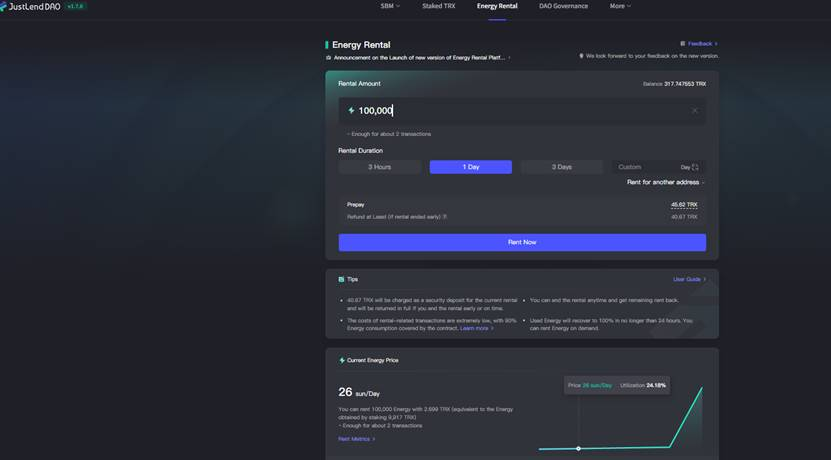
[Method 3: Leasing Energy]
Among these, the most noteworthy is "Energy Leasing," a unique economic ecosystem within the TRON ecosystem. Its core relies on the shared nature of TRON Energy: TRX stakers can share their Energy with other addresses, granting any user the ability to temporarily access others' idle Energy. Under this leasing model, users don't need to stake large amounts of TRX long-term; instead, they pay a small amount of rent to obtain a corresponding amount of Energy on demand, meeting short-term on-chain operational needs .
Whether it's a temporary individual transfer of USDT, team development, or frequent calls to contract interfaces by a project, all can be flexibly adapted to the needs of users. This leasing model creates a win-win situation: users save costs and stakers earn returns. For on-chain users, there's no need to lock up TRX long-term. By renting energy on-demand and on a per-use basis through the leasing platform, they can easily complete short-term operations (such as participating in DeFi mining and minting NFTs). This not only saves on capital tied up, but also significantly lowers the barrier to entry for using complex DApps. For TRX stakers, by renting out their idle energy, they can earn additional income from the rental income, transforming "staking TRX" from a simple "ecosystem contribution" into a dual value of "contribution + profit," significantly improving capital utilization efficiency.
A large number of professional energy leasing platforms have emerged in the market, including the Energy Rental service launched by JustLend DAO, the official lending platform of the TRON ecosystem, as well as professional third-party leasing platforms such as Catfee and TRONEnergy. These platforms accurately match supply and demand, providing a variety of service models such as "pay-per-use leasing" and "on-demand customization", allowing idle energy to break the limitation of "only personal holding", promote its efficient circulation within the ecosystem, and further release the value of resources.
Today, the energy leasing business has become a unique and vibrant financial scenario in the TRON ecosystem. It not only reduces the on-chain participation cost for ordinary users, but also activates idle assets for staking users. It also improves the overall efficiency of TRX staking through efficient resource allocation. From the three dimensions of user experience, asset value, and ecological circulation, it consolidates TRON's core competitive advantage of "low cost, high vitality".
JustLendDAO's official energy rental service (Energy Rental): A core tool that saves over 70% of gas costs per transaction on TRON
Currently, on the TRON network, leasing Energy is the optimal solution for both low-frequency users and high-frequency contract callers, developers, and traders. Compared to directly consuming TRX to acquire Energy, the leasing model can help users save approximately 70%-80% on the cost of a single smart contract operation (such as transfers, minting, and lending).
JustLend DAO, the TRON ecological lending platform, pioneered the launch of the Energy Rental service as early as 2023. With its advantages of "no collateral required, security, flexibility, and controllable costs," it has become a core tool for users to reduce on-chain costs. It is also the largest energy rental channel in the current TRON network.
Currently, the energy leasing market is still in its early stages of development, and ordinary users often face concerns about the security of third-party platforms and the lack of transparency in pricing and fee details. JustLend DAO, the official lending application of the TRON ecosystem, has locked up over $8 billion in crypto assets (TVL). Its energy leasing service offers a secure and reliable foundation of trust, transparent fees throughout the service process with no hidden costs, and a direct connection to the TRON mainnet, making it the preferred and safest platform for users to acquire energy.
According to official website data, JustLend DAO's energy leasing service provides more than 50 billion units of energy per day, the daily leased energy scale exceeds 10 billion units, and a total of 68,300 users have participated.
JustLend DAO's energy leasing service has a very clear operational logic. Users can quickly complete the leasing process with just a few simple clicks, without any complicated steps. Specifically, the operation is divided into the following three steps:
1. First, fill in the rental data: rental amount, rental duration, and rental address.
The rental amount is the amount of energy required, with the minimum rental unit being 100,000 (note that a single USDT transfer requires approximately 120,000 energy, which can be matched on demand by the user);
The rental period can be rented by the hour or by the day, with a maximum of 30 days. Users can choose according to their own operation frequency. For example, for high-frequency interactions in a single day, you can choose "1 day", while for long-term project development, you can choose "30 days";
The receiving address is the target address to which the energy will be distributed. If you are renting for yourself, you do not need to fill it in. If you are renting for someone else, you must enter the corresponding address accurately.
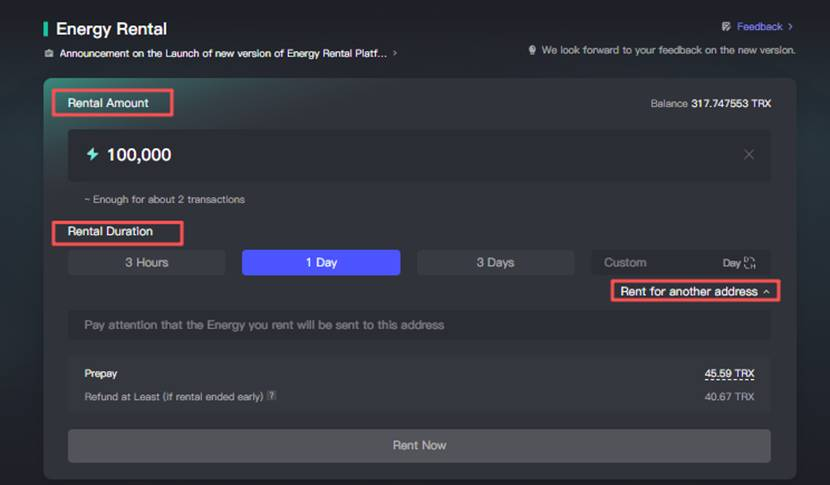
2. Submit a rental order and pay the advance payment : Energy leasing adopts the "prepayment model" and requires payment of three parts of fees: energy rental (core cost), deposit (refundable after the lease ends), and liquidated damages (security deposit to avoid illegal operations). All fee details are real-time and transparent, with no hidden costs.
For example, if you lease 100,000 units of energy for one day, you will need to prepay a total of 45.5 TRX.
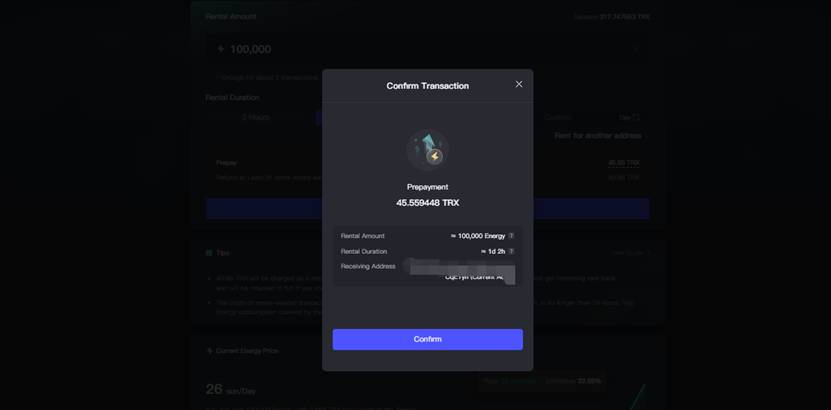
3. End the lease and refund the deposit : After the lease is completed, you can manage the order in real time on the "Energy Leasing Interface": support for refunding rent (ending the lease early), extending the lease period (additional fees required), and checking the remaining energy and lease period.
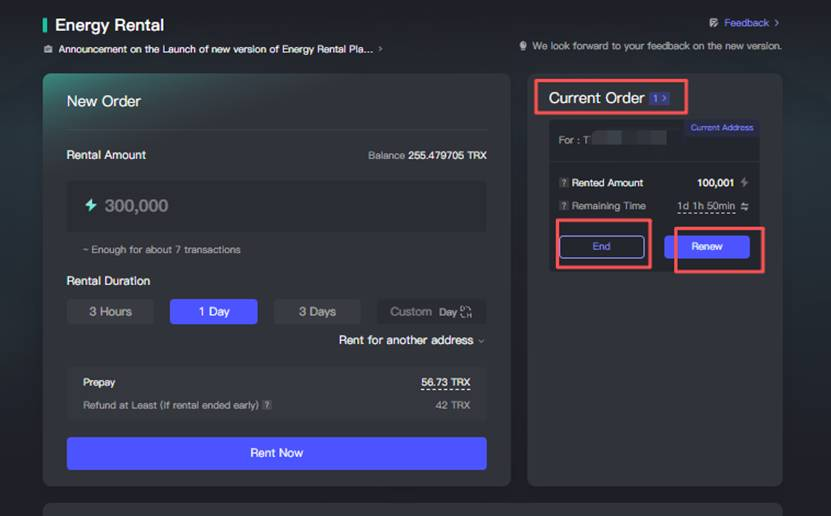
Tips: If you only need to complete a single transaction, it is recommended to return the energy immediately after the operation to avoid extra fees if it is idle. If you have frequent daily transactions (such as multiple DeFi operations per day), it is recommended to choose a long-term lease of 30 days.
From an actual cost perspective, the advantages of JustLend DAO's leasing service are particularly significant: taking the common USDT transfer on TRON as an example, directly burning TRX would consume a corresponding energy cost of approximately US$4.3, while leasing energy through JustLend DAO only costs US$1.17, saving over US$3 per transaction and reducing costs by more than 70%.
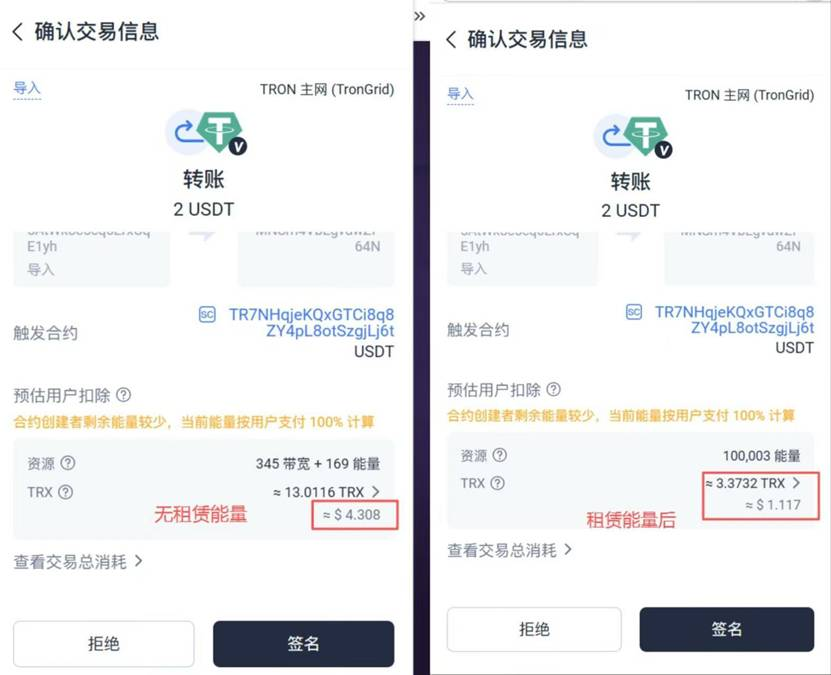
Cost comparison of transferring USDT without leasing energy vs. transferring USDT with leasing energy
From the above operation process, we can see that JustLend DAO's energy leasing has three core advantages:
First, there is no need to lock up funds, and funds are flexible. Users do not need to stake large amounts of TRX long-term in exchange for Energy. Instead, they can "rent as needed" and rent the corresponding amount according to actual needs, avoiding the opportunity cost of long-term capital occupation. This is particularly suitable for scenarios where Energy is temporarily needed, such as single NFT minting and short-term DeFi interactions.
Second, it is easy to operate and supports multiple scenarios . This service is open to all TRON users and supports "one-to-many leasing." Users can rent Energy for their own addresses or for others, meeting the needs of individuals, teams, and project owners.
Third, costs are controllable and high-frequency friendly. Energy can be directly deducted from the gas fees of smart contract operations. For high-frequency trading users, such as GameFi players and DeFi arbitrageurs, long-term leasing can continuously reduce costs and avoid the problem of "accumulating excessive TRX burning fees."
Crucially, following a 60% drop in the price of TRON energy on August 29th, JustLend DAO responded on September 1st by reducing the base tax rate on energy leasing from 15% to 8%. Users leasing energy on JustLend DAO now enjoy the dual benefits of a lower base price and a reduced leasing tax rate.
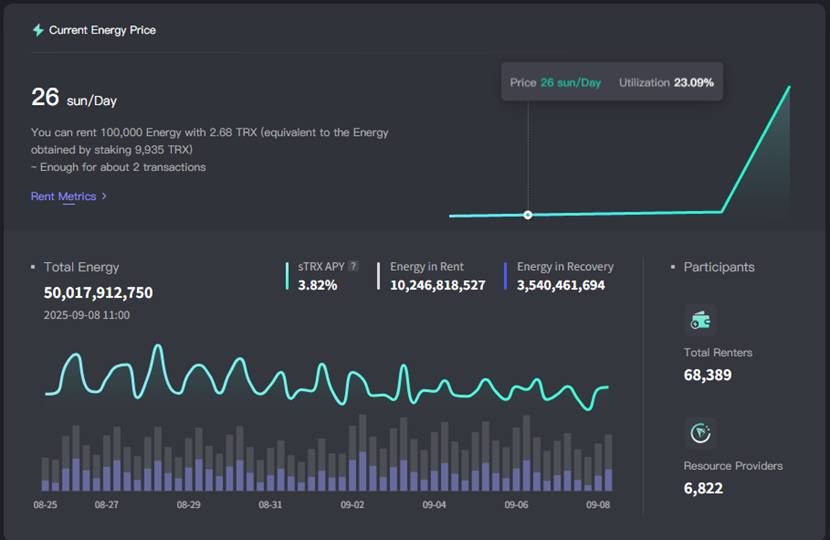
Currently, the energy price of JustLend DAO's energy leasing service is approximately 26 SUN/day. It only costs 2.62 TRX to lease 100,000 units of energy (equivalent to the energy obtained by staking 9,935 TRX), which is enough to cover two contract transactions, further amplifying the cost advantage.
JustLend DAO Launches GasFree Smart Wallet: Pay Gas Fees Directly with Transfer Tokens, Making Crypto Transfers as Easy as Sending a Message
To enhance the user experience on-chain, JustLend DAO not only offers energy leasing services to reduce gas costs, but also launched the innovative GasFree Smart Wallet feature in March of this year, further addressing the core pain point of crypto- to-cryptocurrency transfers: users no longer need to hold network-native tokens (such as TRX) to pay gas fees. Whether transferring TRC20 or ERC20 tokens, the fees are deducted directly from the transferred tokens. This mechanism breaks the traditional restriction of "must pay network fees in native tokens" and provides a frictionless gas payment solution for token transfers, making crypto-to-cryptocurrency transfers more accessible to everyday users.
GasFree's ultimate vision goes beyond this: it aims to enable users, regardless of whether they're using TRON, Ethereum, or other blockchains, to easily transfer assets through a single interface—without having to understand underlying technical details or prepare various native tokens in advance. Ultimately, GasFree aims to make "cryptocurrency transfers as easy as sending an email," while balancing the security of a decentralized environment with the interoperability required for global payments, making blockchain transfers a true part of everyday life.
This innovative "transfer-to-coin, pay-to-charge" design simplifies the previously cumbersome process of "exchange native currency → initiate transfer → pay gas" to a two-step process of "directly initiate transfer → deduct the corresponding token as a handling fee." This not only significantly improves operational efficiency but also significantly reduces the learning curve for new users, making crypto transfers more intuitive and easy to use. Both novice and experienced users can enjoy a seamless asset transfer experience, eliminating the worry of gathering native currency to pay gas.
In April of this year, TRON founder Justin Sun stated at the "BUIDL 2025" crypto conference in Hong Kong that GasFree eliminates the need for individual users to worry about paying and calculating gas fees. It is an even more significant solution for institutional users, many of whom seek to integrate blockchain technology for efficient settlement but are reluctant to directly hold highly volatile cryptocurrencies. GasFree allows institutions to send and receive funds simply through an address, without having to touch the native crypto assets. This significantly lowers the barrier to entry, promotes broader ecosystem integration, and promotes the large-scale adoption of blockchain technology.
The same month GasFree launched, TronLink, the TRON ecosystem wallet, was the first to integrate the feature. Users simply open the TronLink app or browser extension, click GasFree, and instantly experience this new transfer method . Currently, this feature supports TRC20-USDT transfers, with expansion planned for more asset types. To enhance the user experience, JustLend DAO also introduced a 90% fee subsidy. With this subsidy, users only pay approximately 1 USDT per USDT transfer. Please note that the first use of the GasFree Smart Wallet on TronLink requires a one-time activation fee, currently only 1 USDT.
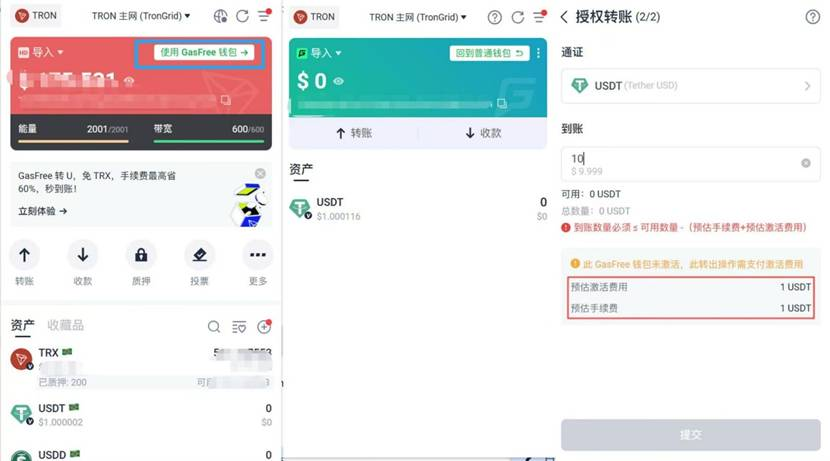
【Use GasFree to transfer USDT for only 1 USDT】
As of now, dozens of mainstream wallets such as imToken and Klever have integrated GasFree. It is expected that more platforms will gradually support it in the future, further expanding its scope of use.
Judging from the actual results, GasFree has demonstrated strong ecological value: as of September 8, the function has completed a cumulative transaction volume of up to US$15.8 billion, with more than 750,000 transactions, saving users nearly US$2.2 million in gas fees, which directly confirms its role in "reducing costs and increasing efficiency."

In addition to the innovative payment experience, GasFree also excels in technical adaptability: it is compatible with any TRC20 or ERC20 token, does not rely on the implementation logic of a specific token, and provides standardized interfaces and smart contract templates. Projects can implement "one-click deployment" of a gas-free transaction system, significantly lowering the threshold for new tokens to access the ecosystem and further expanding GasFree's application coverage and applicable scenarios.
To comprehensively reduce usage costs for users and developers, GasFree recently officially launched the Developer Center. The platform provides one-stop energy management service tools covering "energy cost prediction, automatic energy leasing, optimization suggestions, etc.", helping developers to effectively control energy consumption when integrating GasFree functions, simplifying the development and deployment process of DApps, allowing developers to focus more on product innovation without having to pay too much attention to the underlying energy cost issues of the network, and achieving the dual optimization of "convenient transfer on the user side + efficient development on the developer side".
The launch of GasFree marks another solid step forward for the TRON ecosystem in its continuous innovation and improved user experience. With the integration of more wallets and platforms, users will enjoy lower transfer costs and more convenient operations. This not only optimizes the interactive experience within the TRON ecosystem but also, through its innovative model of "breaking the reliance on native tokens," provides a practical reference for the inclusive development of the entire blockchain industry.




